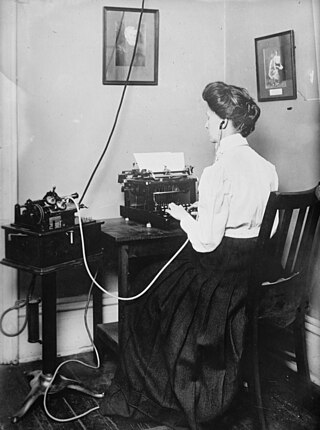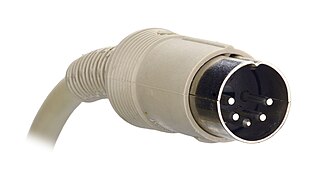
The Compact Cassette, also commonly called a cassette tape, audio cassette, or simply tape or cassette, is an analog magnetic tape recording format for audio recording and playback. Invented by Lou Ottens and his team at the Dutch company Philips, the Compact Cassette was released in August 1963.

Digital Audio Tape is a signal recording and playback medium developed by Sony and introduced in 1987. In appearance it is similar to a Compact Cassette, using 3.81 mm / 0.15" magnetic tape enclosed in a protective shell, but is roughly half the size at 73 mm × 54 mm × 10.5 mm. The recording is digital rather than analog. DAT can record at sampling rates equal to, as well as higher and lower than a CD at 16 bits quantization. If a comparable digital source is copied without returning to the analogue domain, then the DAT will produce an exact clone, unlike other digital media such as Digital Compact Cassette or non-Hi-MD MiniDisc, both of which use a lossy data-reduction system.

Digital Video Broadcasting (DVB) is a set of international open standards for digital television. DVB standards are maintained by the DVB Project, an international industry consortium, and are published by a Joint Technical Committee (JTC) of the European Telecommunications Standards Institute (ETSI), European Committee for Electrotechnical Standardization (CENELEC) and European Broadcasting Union (EBU).

Dictaphone was an American company founded by Alexander Graham Bell that produced dictation machines. It is now a division of Nuance Communications, based in Burlington, Massachusetts.

Video 2000 is a consumer videocassette system and analogue recording standard developed by Philips and Grundig to compete with JVC's VHS and Sony's Betamax video technologies. It was designed for the PAL color television standard, but some models additionally handled SECAM. Distribution of Video 2000 products began in 1979 exclusively in Europe, South Africa and Argentina and ended in 1988.

The DIN connector is an electrical connector that was standardized by the Deutsches Institut für Normung (DIN), the German Institute for Standards, in the mid 1950's, initially with 3 pins for mono, but when stereo connections and gear appeared in late 1950's, versions with 5 pins or more were launched. The male DIN connectors (plugs) feature a 13.2 mm diameter metal shield with a notch that limits the orientation in which plug and socket can mate. The range of DIN connectors, different only in the configuration of the pins, have been standardized as DIN 41524 / IEC/DIN EN 60130-9 ; DIN 45322 ; DIN 45329 / IEC/DIN EN 60130–9 ; and DIN 45326 / IEC/DIN EN 60130-9.
Blaupunkt GmbH was a German manufacturer, producing mostly car-audio gear and other electronic equipment. Owned by Robert Bosch GmbH from 1933 until 1 March 2009, it was sold to Aurelius AG of Germany. It filed for bankruptcy in late 2015 with liquidation proceedings completed in early 2016. The brand, now managed by GIP Development SARL of Luxembourg, is licensed for use by various product groups worldwide.
Digital Speech Standard (DSS) is a proprietary compressed digital audio file format defined by the International Voice Association, a consortium of Olympus, Philips and Grundig Business Systems.
Nero AG is a German computer software company that is especially well known for its CD/DVD/BD burning suite, Nero Burning ROM. The company's main product is Nero 2019, a piece of software that comprises burning, file conversion, media management, and video editing functions and was updated on an annual basis, though new releases have not occurred for several years.

Grundig is a consumer electronics manufacturer owned by Arçelik A.Ş., the white goods manufacturer of Turkish conglomerate Koç Holding. The company makes domestic appliances and personal-care products.
The Mini-Cassette, often written minicassette, is a magnetic tape audio cassette format introduced by Philips in 1967.
Eppendorf, a company with its registered office in Germany, develops, produces and sells products and services for laboratories around the world.

A dictation machine is a sound recording device most commonly used to record speech for playback or to be typed into print. It includes digital voice recorders and tape recorder.

The Steno-Cassette is an analog cassette format for dictation, introduced by Grundig in 1971. It gained widespread use in Germany, where it was established as a DIN standard in 1985. It is easily distinguished from other dictation cassette formats by the integrated tape counter index, showing the amount of tape available.
Gigaset AG, formerly known as Siemens Home and Office Communication Devices, is a German multinational corporation based in Bocholt, Germany. More active in the area of communications technology, it manufactures DECT telephones.

Speech Processing Solutions is an international electronics company headquartered in Vienna, Austria. The company designs, develops, manufactures and markets speech processing devices, such as those used in digital dictation and speech recognition. Speech Processing Solutions was formed on 1 July 2012. Philips Speech Processing was part of the Philips Consumer Lifestyle sector. Speech Processing Solutions is now an official licensee of the Philips brand. The company has subsidiaries in the US, Canada, Australia, the United Kingdom, Belgium, France and Germany, and employs around 170 people worldwide.

Friwo Gerätebau GmbH is a German company, headquartered in Ostbevern, Germany. Its origin can be traced back to 1881. Since the development of the first power supply unit in 1971, the company operates worldwide and manufactures battery chargers, battery packs, power supplies, LED drivers and drive units. The company also provides electronic design and manufacturing services (E²MS) in Europe.
The single-hole cassette,, was a concept of a high fidelity suitable magnetic tape cartridge or cassette from Philips for analog recordings. Tape and tape speed were identical to the Compact Cassette. It was never released to the public.

DC-International is a tape cassette format developed by Grundig and marketed in 1965. DC is the abbreviation of "Double Cassette", as the cassette contained two reels; International was intended to indicate that, from the beginning, several companies around the world supported the format with suitable tape cassette tape recorders, recorded music cassettes and blank cassettes. Since DC-International did not compete effectively against the similar Compact Cassette, it was discontinued in 1967.

















